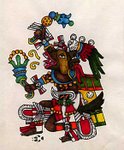La Fiesta de la Epifanía, la Fiesta de la Luces, Día de Reyes (6 de enero de nuestro calendario común) tiene sus orígenes más antiguos en una fiesta egipcia de la bajada del Nilo del cielo (llamada Chabas en el calendario copto); en este día las aguas fueron bendecidas.
Aristides Rhetor (c. 160) escribe que en este día, en pleno invierno, las aguas del Nilo estaban en su punto más puro y se decía que permanecían frescas sin importar cuánto tiempo estuvieran almacenadas. A la medianoche del 5 de enero y durante el día 6 de enero se recogía el agua. Las galeras se llevaban enormes jarras, ánforas, para transportarlas a Italia y otros lugares para usarlas en libaciones en los templos de Isis durante todo el año. Se dijo que en esta noche y día en muchos lugares (come Cibira en Caria y Gerasa en Arabia) los manantiales y los ríos se convertían en vino.
Epifanio (c. 370) relata que en Alejandría el 5 de enero los devotos se reunían en el Templo de la Doncella (Kore) y cantaban himnos hasta el amanecer e iban con antorchas a su santuario subterráneo y traían la imagen de la diosa, sentada desnuda, con cruces marcadas en su frente, manos y rodillas. Con himnos y bailes, fue llevada siete veces alrededor del santuario antes de ser devuelta a su morada abajo. Los devotos dijeron que en este día ella dio a luz a Eón (Ser Eterno.)
El 6 de enero es mencionado por primera vez por Clemente de Alejandría como una fiesta cristiana alrededor de 194; llegó a establecerse como el día del nacimiento de Cristo mucho antes de que se cambiara al 25 de diciembre (336) bajo Constantino para coincidir con las Saturnales y fiesta del nacimiento del dios Mitra, celebraciones romanas del solsticio de invierno.) El 6 de enero se anunciaba la fecha de la próxima Semana Santa. Todavía en 386, la Epifanía y la Pascua eran las principales fiestas cristianas. Eventualmente, la fiesta establecida originalmente para celebrar el nacimiento de Cristo, el bautismo de Jesús y el milagro de Caná (el primer milagro del Nazareno en el que convierte el agua al vino) se estableció para conmemorar la venida de los Magos a Belén.
Que nos unamos a las filas de los sabios en la realización de la luz.
Rafael Jesús González
(basado en el artículo de la Enciclolpedia Británica,
11.ª edición)
The Feast of the Epiphany, the Feast of Lights, 12th Day (January 6 of our common calendar), has its most ancient origins probably in an Egyptian feast of the descent of the Nile from heaven (called Chabas in the Coptic calendar); on this day the waters were blessed.
Aristides Rhetor (c. 160) writes that on this day at the height of winter, the waters of the Nile were at their purest and said to remain fresh no matter how long they were stored. At midnight on January 5 and during the day of January 6, the water was gathered. Galleys took huge jars, amphorae, to transport to Italy and elsewhere to be used for libations in the temples of Isis throughout the year. It was said that on this night and day in many places (such as at Cibyra in Caria and Gerasa in Arabia) springs and rivers turned into wine.
Epiphanius (c. 370 ) relates that in Alexandria on January 5 or 6 votaries met in the Temple of the Maiden (Kore) and sang hymns until dawn and went with torches to her shrine underground and brought up the image of the goddess, seated naked, with crosses marked on her brow, hand, and knees. With hymns and dances she was carried seven times around the shrine before being restored to her dwelling-place below. The votaries said that on this day she gave birth to Aeon (Eternal Being.)
January 6 is first mentioned by Clement of Alexandria as a Christian feast circa 194; it came to be set as the day of the birth of Christ long before it was changed to December 25 (336 AD under Constantine to coincide with the Saturnalia and feast of the birth of the god Mithras, Roman celebrations of the Winter Solstice.) On January 6 was announced the date of the forthcoming Easter. As late as 386 Epiphany and Easter were the chief Christian feasts. Eventually the feast originally set to celebrate the birth of Christ, the baptism of Jesus, and the miracle of Cana (the Nazarene’s first miracle in which he turns water into wine,) was set to commemorate the coming of the Magi, the Wise Men, to Bethlehem.
May we join the ranks of the wise in realization of the light.
Rafael Jesús González
(based on the article in the Encyclopedia Britannica 11th Edition)
Mexico, 19 cent.
-




No comments:
Post a Comment